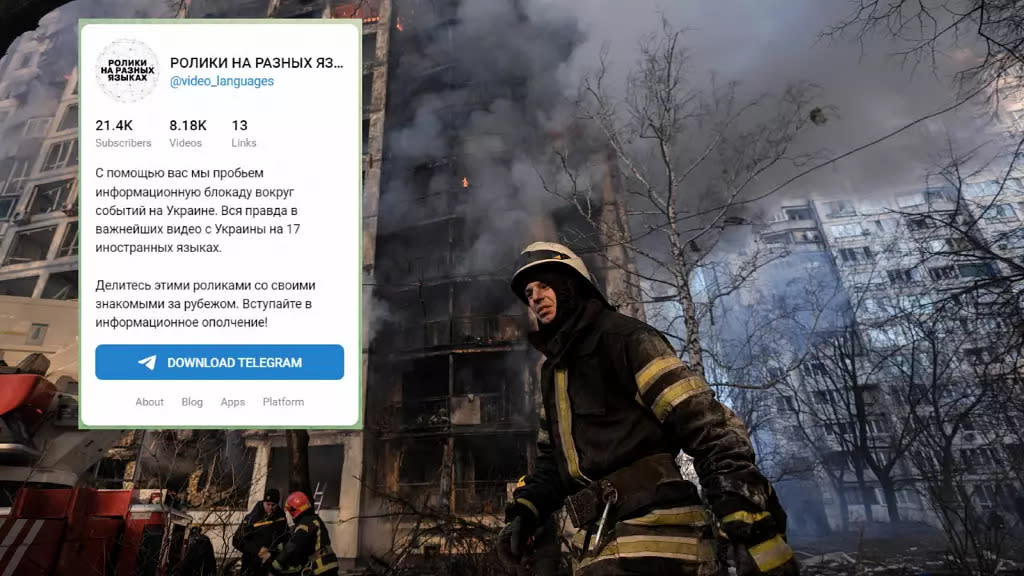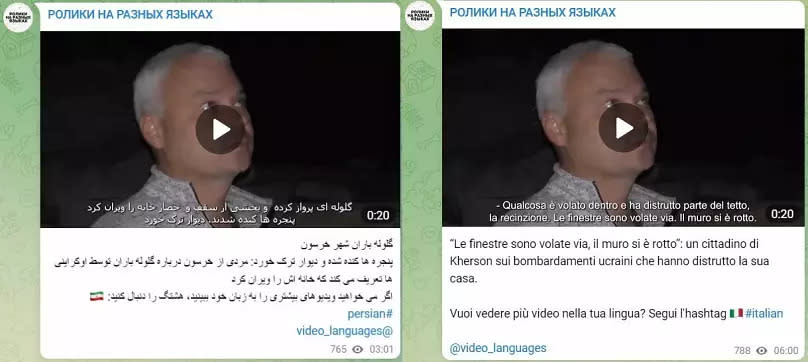Ukraine war: How Russian propaganda has found a way of 'avoiding detection' online

Russia has devised a new strategy to spread disinformation to potentially millions of people while avoiding detection, experts say.
The Kremlin's propaganda wing is considered a key weapon in its war against Ukraine but it has faced a crackdown in recent months.
Now, Russia is using social media network Telegram to help it bypass telltale signs that would identify content as Moscow-backed propaganda to tech giants like Twitter, according to a report by Nisos, a US-based intelligence firm.
Researchers found a channel on Telegram being used as a digital warehouse storing thousands of videos translated into up to 18 languages, including English, Arabic and Chinese.
Once on Telegram, the videos can be downloaded and shared on Twitter and other networks without any indication that they were produced by Russian state-affiliated media, Nisos said.
It means Kremlin propaganda could be spread without it being flagged by mainstream social media companies that have tried to cut down on disinformation on their networks.
“The genius of this approach is that the videos can be downloaded directly from Telegram and it erases the trail that researchers try to follow," Nisos' senior intelligence analyst Patricia Bailey said.
The Telegram group, which researchers say is sponsored by RT, writes that it is attempting to "break the information blockade around the events in Ukraine" in its description.
"All the truth in the most important videos from Ukraine in 17 foreign languages. Share these videos with your friends abroad. Join the information militia!" the group's bio reads.
Over 8,000 videos have been shared such as apparent testimonies from alleged victims of Ukrainian shelling and messages of support for Russian troops by people living in Ukraine.
Some of the footage has a green RT logo of the state-owned media outlet -- though it appears to have been blurred out in other videos on the group.
"The overall goal, consistent with Russian propaganda objectives, is to reframe the narrative on the war in Ukraine," Nisos wrote in its report.
"The channel’s videos all tell the same story from different angles, claiming that the Russian military is generously saving a Ukrainian population besieged by a corrupt, genocidal government and by Nazi militants."
Videos are also translated into languages such as Portuguese, Italian, Persian, French and Vietnamese.
When the Telegram group launched in April 2022, RT’s editor-in-chief Margarita Simonyan said it was part of the “people’s information militia” to facilitate the global spread of pro-Russia perspectives.
It came in response to a Western ban on Russian state-owned media channels, including RT, across channels such as YouTube, Facebook and Instagram.

The videos can be shared on Twitter without being flagged under the network's labelling system, which alerts users if the content is produced by Russian state media.
Videos are also posted on other networks including TruthSocial, the social media site set up by former US president Donald Trump, researchers at Nisos found.
Of 275 Twitter profiles analysed by Nisos that had shared videos from the Telegram group, researchers found that almost half had posted in exactly the same format, which they say is a sign of a coordinated disinformation effort.
Nisos said that a quarter of all the accounts sharing the content displayed "bot-like characteristics" based on their activity patterns, followers and language.
However, researchers noted that some users may have been sharing the videos independently.
Twitter said it labels content it can identify as coming from Russian state media.
“We use labels to make it clear on Twitter when an account is operated by a state actor, such as a state-backed media outlet, and we will not recommend or amplify Tweets from these types of accounts,” a Twitter spokesperson said.
Russian propaganda crack-down
Governments and tech companies have moved to counter Russian propaganda since the start of the war in Ukraine.
In March, the EU suspended the broadcasting activities of Sputnik and RT/Russia Today in the bloc until the Kremlin ends its conflict.
“If the information is systematically contaminated by lies and twisted, citizens can’t have a clear understanding of reality and their political judgment is similarly twisted," said EU diplomat Josep Borrell earlier this year.
Borrell said that Moscow-controlled outlets were part of a well-oiled propaganda machine providing biased news about Vladimir Putin’s true intentions.
Social media companies have also fought back against disinformation being pumped out of Russia.
Google, which owns YouTube, announced in March it was banning Russia's state-owned media from the video-sharing platform.
Meta also barred the same media outlets from Facebook and Instagram.
Twitter removed RT and Sputnik from its platform for users in EU territories to comply with sanctions by the bloc on Russia's state-owned media.

 Yahoo Movies
Yahoo Movies 
